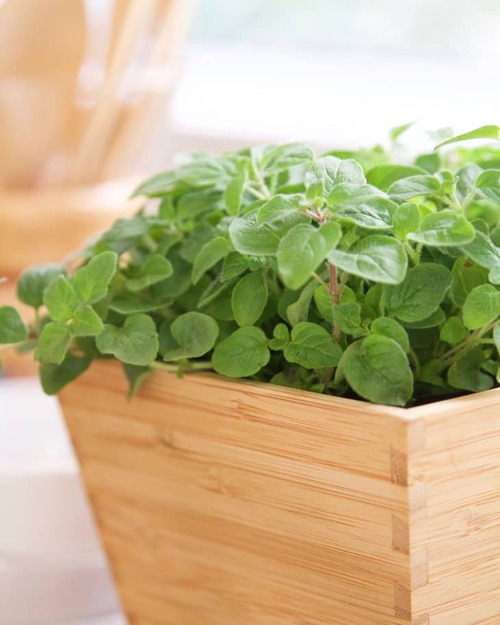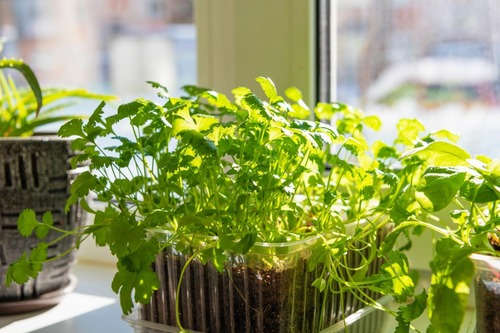Herbs are a fantastic addition to any indoor garden. Not only do they enhance the flavor of your meals, but they also provide a touch of greenery to your home. Growing herbs indoors is both convenient and rewarding, as they require minimal space and are generally easy to care for. Plus, you can have fresh, aromatic herbs available year-round, no matter the season.
In this article, we’ll explore 9 easy-to-grow herbs that thrive indoors, along with tips on how to care for them and maximize your herb garden’s potential.
1. Basil

Basil is one of the most popular herbs for indoor gardening due to its versatility and ease of growth. With its aromatic leaves, basil is a staple in many kitchens, particularly for making pesto, sauces, and salads.
Basil requires plenty of sunlight—about 6-8 hours of direct sunlight a day. Place it near a sunny window or under a grow light if natural light is limited. It thrives in well-drained soil, and give it moist soil but not soggy. Pinch off the top leaves to encourage bushier growth. Avoid letting the plant flower, as this can reduce the flavor of the leaves.
2. Mint

Mint is another excellent choice for indoor gardens. Its refreshing flavor is perfect for teas, desserts, and garnishing dishes. Plus, mint’s hardy nature makes it an easy herb to grow indoors.
Mint prefers indirect light, so place it in a spot where it gets bright, indirect sunlight for about 4-6 hours a day. This low-maintenance herb likes consistently moist soil, so water regularly and ensure it has good drainage. It can be invasive if left unchecked. Growing it in a container helps contain its growth and keeps it manageable indoors.
3. Thyme

Thyme is a hardy herb with a woody stem and small, fragrant leaves. It’s often used to flavor meats, soups, and roasted vegetables. Its compact growth habit makes it perfect for indoor gardening.
Thyme thrives in bright light, requiring at least 6 hours of sunlight daily. A sunny windowsill is ideal for thyme. Water sparingly, as thyme prefers drier soil. Allow the soil to dry out slightly between waterings. Regular pruning will encourage more growth and keep the plant from becoming too leggy.
4. Parsley

Parsley is more than just a garnish. This herb is rich in vitamins and can be used in salads, sauces, and soups. It’s relatively easy to grow indoors, making it a great choice for beginners.
Parsley grows best in bright, indirect light. It can tolerate lower light conditions, but for optimal growth, place it in a spot with about 4-6 hours of indirect sunlight. It loves growing in consistent moisture so keep the soil evenly moist but avoid overwatering. Start harvesting when the plant has developed several stems. Cut the outer leaves first, allowing the inner ones to continue growing.
5. Chives

Chives are a member of the onion family and are known for their mild, onion-like flavor. They’re one of the easiest herbs to grow indoors, and their grass-like appearance adds a decorative touch to your herb garden.
Chives need about 4-6 hours of sunlight daily. They do well on a sunny windowsill. Keep the soil consistently moist but not waterlogged. Chives prefer well-draining soil. Cut the leaves close to the base, starting with the outermost leaves. Regular harvesting promotes new growth.
6. Oregano

Oregano is a robust herb often used in Italian, Greek, and Mexican dishes. Its bold flavor makes it a must-have in many kitchens. Growing oregano indoors is relatively simple, especially if you can provide it with enough sunlight.
This herb requires at least 6 hours of direct sunlight daily. Place it in a sunny location or use a grow light if necessary. Water sparingly, allowing the soil to dry out between waterings. Oregano prefers slightly dry conditions. Regular pruning encourages bushy growth and prevents the plant from becoming too woody.
7. Cilantro

Cilantro, also known as coriander, is a versatile herb used in a wide variety of cuisines, from Mexican to Asian dishes. While cilantro can be a bit finicky outdoors, it grows well indoors with the right conditions.
Cilantro prefers 4-6 hours of indirect sunlight. Avoid placing it in direct sunlight, which can cause the plant to bolt (go to seed) prematurely. Keep the soil consistently moist, but don’t let it become waterlogged. Cilantro enjoys moist, well-drained soil. Harvest cilantro leaves when they are young and tender for the best flavor. Regular harvesting helps prevent the plant from flowering too soon.
8. Rosemary

Rosemary is a fragrant herb with needle-like leaves, often used in roasts, breads, and soups. It can also be used as an ornamental plant due to its attractive foliage. Growing rosemary indoors is relatively easy, as long as it receives plenty of light.
Rosemary needs a lot of sunlight—at least 6-8 hours of direct sunlight a day. Place it in the brightest spot you have or use a grow light. Allow the soil to dry out between waterings. Rosemary is drought-tolerant, and overwatering can cause root rot. Use a well-draining container, as rosemary doesn’t like wet roots.
9. Sage

Sage is another easy-to-grow herb, known for its earthy flavor that pairs well with poultry, meats, and vegetables. Its attractive grayish-green leaves make it a lovely addition to an indoor herb garden.
Sage requires at least 6 hours of sunlight daily. A sunny window or grow light will ensure it thrives. It prefers well-drained soil and doesn’t like to sit in water. Allow the top inch of soil to dry out before watering. Regular pruning will keep your sage plant healthy and encourage fuller growth.
Some Care Tips
While these herbs are easy to grow indoors, there are a few general tips to ensure they thrive in your indoor garden:
Light
Most herbs need at least 4-6 hours of sunlight daily, so place your herb garden near a sunny window. If natural light is limited, consider investing in a grow light to provide your plants with the necessary light for growth.
Watering
Indoor herbs need regular watering, but it’s important not to overwater them. Always check the soil moisture by sticking your finger about an inch into the soil. If it feels dry, it’s time to water. Ensure that your pots have drainage holes to prevent water from accumulating at the bottom.
Soil
Use a high-quality potting mix designed for indoor plants. Herbs prefer well-draining soil, so consider adding perlite or sand to your potting mix to improve drainage.
Temperature and Humidity
Most herbs grow best in temperatures between 65-75°F (18-24°C). Keep them away from drafts or heating vents that can cause temperature fluctuations. Some herbs, like basil and cilantro, prefer slightly more humid environments, so consider using a humidity tray or misting your plants occasionally.